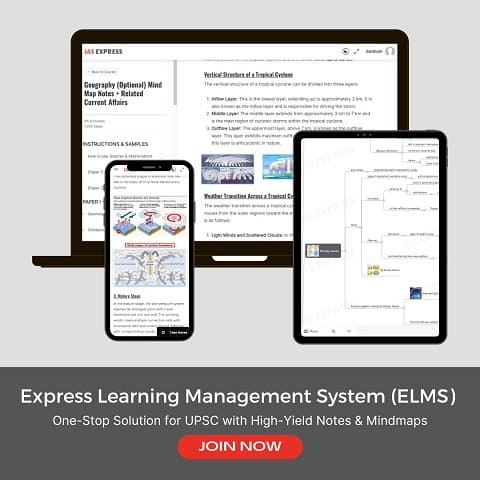NAKSHA Scheme: Transforming Urban Land Records in India

From Current Affairs Notes for UPSC » Editorials & In-depths » This topic
IAS EXPRESS Vs UPSC Prelims 2024: 85+ questions reflected
Urban land management in India has long been plagued by outdated and inconsistent records, leading to inefficiencies in governance, disputes over ownership, and hindrances in urban planning. Recognizing these challenges, the Indian government has launched the NAKSHA (National Geospatial Knowledge-based Land Survey of Urban Habitations) initiative. Introduced under the Digital India Land Records Modernization Programme (DILRMP), NAKSHA aims to streamline urban land records using advanced geospatial technology. This article explores the objectives, implementation process, benefits, and challenges associated with the scheme.
What is the NAKSHA Scheme?
- NAKSHA is an urban land survey initiative under DILRMP, led by the Department of Land Resources (DoLR), Ministry of Rural Development.
- The project focuses on creating a comprehensive and accurate geospatial database of urban land records.
- Uses aerial and field surveys with GIS technology to improve land governance, urban planning, and property transactions.
- Launched in 152 urban local bodies across 26 states as a pilot phase.
- Covers cities with an area of less than 35 sq km and a population under 2 lakhs.
- The pilot phase is set to be completed in one year before national expansion.
Why Was the NAKSHA Programme Needed?
- Urban Land Record Issues: While rural areas have seen improved land records, many urban areas lack updated maps.
- Outdated Systems: Most cities, except states like Tamil Nadu, Maharashtra, Gujarat, and Goa, still rely on manual or fragmented records.
- Taxation and Revenue: Unstructured land records lead to revenue losses for urban local bodies due to improper taxation.
- Urban Planning Challenges: Accurate geospatial data is necessary for effective urban development.
- Government’s Digital Push: Aligns with the 2024-25 Union Budget initiative to modernize urban land records and governance.
Key Features of NAKSHA
- 100% Centrally Funded: The pilot project has an estimated budget of Rs. 194 crore.
- Advanced Technology: Utilizes drones, LiDAR sensors, and GIS-based mapping.
- Cost Variability: Mapping costs range from Rs. 25,000 to Rs. 60,000 per sq km, depending on camera type.
- Urban Expansion Plan: Aims to extend across 4,912 urban local bodies post-pilot phase.
- Property Integration: Links ownership records, tax details, and land use plans into a digital database.
How Will the NAKSHA Survey Be Conducted?
Three-Stage Process:
- Aerial Survey:
- Drones capture high-resolution images using simple and oblique-angle cameras.
- 5 cm ground resolution (far superior to satellite images from ISRO or ESA).
- Data is processed into geospatial maps.
- Field Verification:
- Ground surveys validate aerial data.
- Ownership, property tax records, and legal documentation are cross-verified.
- 2D/3D models are created for accuracy.
- Public Review and Finalization:
- Draft maps are opened for public claims and dispute resolution.
- Objections are addressed before final maps are published.
Benefits of the NAKSHA Scheme
- Transparent Land Ownership: Reduces fraudulent registrations and ensures secure transactions.
- Improved Taxation System: Enables accurate property tax collection for urban local bodies.
- Boost to Urban Planning: Facilitates smart city development and infrastructure planning.
- Easier Access to Credit: Provides verified land ownership records to aid in loan approvals.
- Reduced Land Disputes: Proper documentation minimizes litigation cases and property conflicts.
- Faster Property Transactions: Streamlines the property buying, selling, and registration process.
- Disaster Management Support: Helps in identifying flood-prone areas and planning evacuation routes.
Challenges in Implementing NAKSHA
- Cadastral Maps Missing: Many cities lack existing base maps for reference.
- Multiple Ownership Issues: Cities have group housing societies, unauthorized colonies, and complex land-sharing models.
- Legal and Bureaucratic Hurdles: Delays in mutation updates and land acquisition processes.
- Manpower and Technological Gaps: Requires trained surveyors and GIS professionals.
- Historical Records Discrepancies: Many urban properties lack clear ownership history, complicating digitization efforts.
- Resistance from Stakeholders: Landowners, local authorities, and real estate entities may resist changes due to perceived losses.
Comparison of NAKSHA with Other Schemes
| Feature | NAKSHA Scheme | SVAMITVA Scheme | DILRMP (Digital India Land Records Modernization Programme) |
|---|---|---|---|
| Objective | Digitization of urban land records using geospatial technology | Digitization of rural property records | Modernization of land records and digitization |
| Coverage | 152 Urban Local Bodies in pilot phase, to be expanded nationwide | Implemented across rural India | Nationwide initiative covering both rural and urban areas |
| Technology Used | Drones, LiDAR, GIS mapping | Drone surveys, GIS mapping | GIS, digital land record management systems |
| Funding | 100% Centrally funded (Rs. 194 crore for pilot) | Centrally funded under Ministry of Panchayati Raj | Centrally funded with state participation |
| Target Area | Urban areas (small towns and cities with <2 lakh population) | Rural areas (villages and gram panchayats) | Both urban and rural areas |
| Implementation | Three-stage process: Aerial survey, field verification, dispute resolution | Drone survey followed by property record verification | Digitization of textual and spatial land records |
| Key Benefits | Improved land governance, reduced disputes, efficient urban planning | Formal property ownership for villagers, access to bank credit | Transparency in land transactions, reduced fraud |
| Challenges | Legal complexities, lack of existing maps, multiple ownership issues | Resistance from rural communities, legal validation issues | Coordination between state and central agencies, legacy data issues |
Future of NAKSHA and Urban Land Reforms
- National Expansion: The project is expected to scale beyond pilot cities to cover entire urban India.
- Integration with Other Schemes: Will align with PM Gati Shakti, SVAMITVA (for rural land), and Digital India initiatives.
- E-Governance Revolution: Establishes a centralized digital land registry for seamless online access.
- State-Level Adaptation: Some states like Maharashtra and Gujarat already maintain urban land property cards, which could be a reference model.
- Private Sector Collaboration: Partnerships with tech companies for GIS and AI integration may improve efficiency.
Conclusion
The NAKSHA scheme represents a significant milestone in India’s urban land governance. By integrating geospatial technology, drone mapping, and AI-driven analytics, the initiative promises to modernize property records, reduce land disputes, and enhance urban planning. However, its success hinges on overcoming bureaucratic, technological, and legal challenges. With careful implementation and stakeholder cooperation, NAKSHA has the potential to transform India’s urban landscape into a transparent, efficient, and digitally empowered ecosystem.
Practice Question
How does the NAKSHA initiative contribute to urban governance and planned city development in India? (250 words)
If you like this post, please share your feedback in the comments section below so that we will upload more posts like this.


